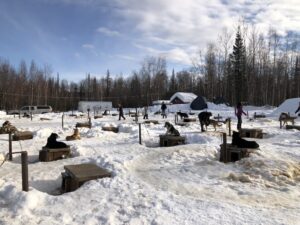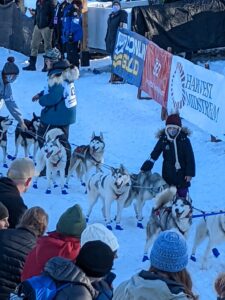I’ve spent the last 8 days in Alaska immersed in the culture of the Iditarod. Today at the Willow Restart, as I watched the mushers take off across the lake and down the trail, I realized I haven’t really talked about the dogs. And the Iditarod is all about the dogs. Watching the them pull at the lines, ready to race, I couldn’t help but think back at all the interactions with dogs this week. These interactions, when pieced together, give a full picture of the love and care everyone involved with this race feels for the dogs.
 The vet checks on Wednesday at Iditarod headquarters helped to frame the entire event. The race begins and ends with dog care. Pre-race testing is extensive and comprehensive; dogs have bloodwork, ECG’s, temperature checks, and heart monitoring. All of the work is done by volunteer vets from around the country who donate their time and expertise. These vets know the dogs want to run and are here to make sure they can do what they love.
The vet checks on Wednesday at Iditarod headquarters helped to frame the entire event. The race begins and ends with dog care. Pre-race testing is extensive and comprehensive; dogs have bloodwork, ECG’s, temperature checks, and heart monitoring. All of the work is done by volunteer vets from around the country who donate their time and expertise. These vets know the dogs want to run and are here to make sure they can do what they love.
Musher Matt Failor shared his time and graciously allowed us to roam his dog yard. He dispelled any misconceptions about his kennel set-up. “We keep them chained because, in the case of an emergency, like a forest fire or something, that chain can work just like a leash. We can grab them and get them out of there.” What I witnessed were dogs happily enjoying their own personal space, yet still appropriately socialized with each other in the dog yard. The decision about how to house this many dogs isn’t made lightly, but with intent and the animals best interest at heart.
dispelled any misconceptions about his kennel set-up. “We keep them chained because, in the case of an emergency, like a forest fire or something, that chain can work just like a leash. We can grab them and get them out of there.” What I witnessed were dogs happily enjoying their own personal space, yet still appropriately socialized with each other in the dog yard. The decision about how to house this many dogs isn’t made lightly, but with intent and the animals best interest at heart.
At the Willow Restart the noise was deafening. There’s barking, and then there’s the “I’m ready to run 1,049 miles, so will you people just let me go” howl. The dogs demanded the attention they were due; they are the athletes after all, and they made sure all ears were on them.

Handlers at the Restart
Deke Naaktgeboren, bib #25, trusted me with one of his dogs, the heart and soul of this race. Siesta, a dark speckled mutt proved to be a handful (and more). I was tasked with leading her up to the restart. Siesta did most of the leading! The power hidden in the dog’s wiry frame took me by surprise. I ended up falling and rolling off to the side when Siesta slipped from my grasp. After brushing myself off and jogging to catch up, I was able to rejoin the handler team. Until this moment I never truly grasped how much these dogs want to run, how much they love to run, how they were born to run. Once I fulfilled my job there was time to watch other teams take off from the start. It was astounding how quickly the dogs synch with each other, finding their rhythm almost immediately. I wish Siesta, and all the other four-legged athletes, a pleasant journey to Nome and I was honored to be part of their experience. Without the handlers the dogs would struggle to safely reach the starting line.
We know the dog care doesn’t finish at the start. This morning I spent time talking with a veterinarian about to fly to Skwentna. She is one of the more than 30 volunteer vets out on the trail. Her story is incredible, but not unusual. Taking a month off from work, paying her own way up here, and heading out to leapfrog checkpoints, all in the name of caring for these special dogs. Her one hope is to not wind up in Ophir. Last year the temperature in Ophir was -70 degrees and some of her colleagues are still suffering from sensitivity in their fingertips and ears from the extreme cold. It never occurred to me, but a vet can’t wear gloves to examine a dog. She stated, “These are elite athletes who suffer mostly from muscle injuries. We can’t tell if anything is swollen if we have gloves on. We can’t hear our stethoscope if our ears are covered”. Most astounding, those vets with lingering effects from last year are back and ready to risk it all again.
One thing about Iditarod is perfectly clear – everyone is here for the love of the dogs.
Teachers: Iditarod dogs are world class athletes. Brainstorm a list of athletes your students look up to. Make a KWL chart for each athlete (or sport) and include Iditarod dogs. Research how they train, what common injuries they might sustain, how they protect themselves from injury (what protective gear they use), how long they can play their sport (average age of retirement). Pull from the student wonderings to answer questions about the support team behind the athlete and compare/contrast to the team of people who care forIditarod dogs.


